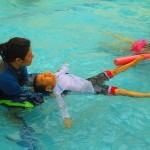 At SSIS, swimming is one of the many physical activities that a child will participate in. The early stage involves understanding and abiding by the safety practices in and around the pool, building water confidence, and learning skills and strokes over a short distance.
At SSIS, swimming is one of the many physical activities that a child will participate in. The early stage involves understanding and abiding by the safety practices in and around the pool, building water confidence, and learning skills and strokes over a short distance.
While some children love the water and learn to swim almost effortlessly, others may find being in the pool or learning to swim terrifying. Parents must understand that readiness of young children to learn swimming skills will depend very largely on their physical, social and cognitive development. Below are some helpful suggestions to develop your kid’s confidence in and around the pool according to Lisa Weber of Everyday Life.
 Recognize the fear. Talk to your child using age-appropriate language about why he is afraid of the water. Do not minimize your child’s fear, or tell there is nothing to be afraid of. However, while it is important to acknowledge your child’s feelings, don’t let your child manipulate you or others with his fear.
Recognize the fear. Talk to your child using age-appropriate language about why he is afraid of the water. Do not minimize your child’s fear, or tell there is nothing to be afraid of. However, while it is important to acknowledge your child’s feelings, don’t let your child manipulate you or others with his fear.
Take it slow. Do not force your child into the pool if he is truly terrified. While watching him closely, let him play alongside the pool and let him watch you and other children enjoy in the water. Provide him with pool toys and flotation devices, and let him gradually ease into the water as you support him.
Use techniques. Get your child used to putting his face in the water by blowing bubbles and pretending to be a fish. Use a toy watering can to pour water over your child’s head to simulate taking a shower. Once your child is comfortable getting into the pool, pretend to be animals in the pool such as a bunny hopping up and down, or a crocodile snapping his arms or legs.
 Enroll in an age-appropriate swimming program. Swim lessons will help a child learn to be safe and confident in water. Know the environment that will be most comforting for your child. Many swimming programs offer a mommy-and-me class that allows the parent into the water with their child. Others require the parents to stay on the sidelines. Other factors to consider include the temperature of the pool, the class size and teacher personality.
Enroll in an age-appropriate swimming program. Swim lessons will help a child learn to be safe and confident in water. Know the environment that will be most comforting for your child. Many swimming programs offer a mommy-and-me class that allows the parent into the water with their child. Others require the parents to stay on the sidelines. Other factors to consider include the temperature of the pool, the class size and teacher personality.
Give a lot of positive reinforcement. This will boost a child’s confidence and self-esteem without inflicting pain or punishment. Give plenty of specific praise, such as “you are so brave to put your head in the water” or “you are the best bubble blower!”
Most importantly, make swimming a very FUN activity!
Contributed by: Ms. Jennifer Aca – Vergara
EC – K Movement and Music Teacher


![[AS] Welcome New Faculty, 2023-2024 (May 2023) Head of School Letter header](https://enews.ssis.edu.vn/wp-content/uploads/2022/08/HOS-Letter-SY22-23-218x150.png)

![[AS] Award-Winning Author Minh Lê Visits SSIS!](https://enews.ssis.edu.vn/wp-content/uploads/2023/04/Minh-Le-218x150.jpg)
![[AS] Annual Community Survey](https://enews.ssis.edu.vn/wp-content/uploads/2022/03/2022-Community-Survey-218x150.jpg)
![[ES] Classroom Placement, 2023-2024 – Opportunity for Parent Input elementary school general graphic](https://enews.ssis.edu.vn/wp-content/uploads/2022/07/ES-eNews-Cover-218x150.png)

![[G6-8] Important End-of-Year Events and Dates](https://enews.ssis.edu.vn/wp-content/uploads/2022/07/MS-eNews-Cover-218x150.png)


![[G9-11] Invitation to University Application Policies and Procedures, Wednesday, 8:00 am](https://enews.ssis.edu.vn/wp-content/uploads/2020/10/University-Application-Process-218x150.jpg)
![[G12] US Student Visa: US Consulate to Provide Information, Monday, May 8, 6:00 – 7:30 pm HS eNews Cover](https://enews.ssis.edu.vn/wp-content/uploads/2022/07/HS-eNews-Cover-218x150.png)



